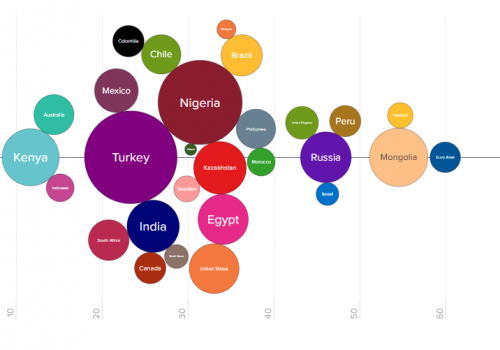What about inflation and the Russia-Ukraine crisis?
The Russia’s invasion of Ukraine is rattling the global economy and markets. In the United States, increasing oil and natural gas prices in the past three weeks have kept the administration on its toes. In his February 22 remarks, President Biden reminded the nation that “defending freedom will have costs for us as well, here at home” and that the “administration is using every tool at its disposal to protect American businesses and consumers from rising prices at the pump.” However, higher gasoline prices are only part of the story. The current crisis will have a wide range of supply chain implications — and consequently higher inflation — for which the administration must plan to mitigate their effects on U.S. consumers.
Chips
A February 1 report published by Techce, a market research group, highlights the world’s and the United States’ dependence on Russian and Ukrainian C4F6, neon, and palladium, all materials critical to semiconductor chips. For example, more than 90 percent of neon used in the U.S. semiconductor industry is supplied from Ukraine. Russia is the world’s largest supplier of palladium — producing roughly 40 percent of the world’s supply — which is a key ingredient in MRAMs. Supply chain disruptions in these materials will exacerbate the pressure on the already strained semiconductor industry, leading to shortages and higher prices in a wide spectrum of products ranging from home appliances to cars (including used cars), electronic gadgets, and industrial machinery. Specifically, over the past two years, chip shortages have led to increasing prices for new and used vehicles, which has been one of the main contributors to high inflation rates in the U.S. economy. The Russia-Ukraine crisis could aggravate conditions in this market, pushing U.S. inflation rates higher.
Ammonium Nitrate, Wheat, and Corn
Russia is responsible for two-thirds of the 20 million metric tons of ammonium nitrate produced annually in the world and is, by far, the largest exporter of this commodity in the world. Declines in corn and wheat yields due to supply disruptions in ammonium nitrate-based fertilizers will increase food inflation, already above 6 percent in the United States. Russia is also the world’s largest exporter of wheat, while Ukraine is the third-largest exporter of corn and a top exporter of barley and rye, making the impact of this crisis especially hard on food markets. Moreover, higher corn prices would translate to higher fuel prices at the pump in the United States, as gasoline consumed in the United States includes 10% of fuel ethanol, most commonly made of corn and sugarcane. Brazil, though a bystander to the current crisis, will be hit the hardest as it is the main recipient of Russian ammonium nitrate exports. It is also the second greatest consumer — after the United States — of fuel ethanol, which constitutes around 50 percent of all fuel consumed in passenger cars and light trucks in Brazil.
Metals
Russia is home to roughly 10 percent of global copper reserves and produces six percent of the world’s aluminum and nickel. Aluminum is central to car production and nickel is a key ingredient in electric car batteries, both of which are trading at high levels not seen in more than a decade. Producing 10 percent of the world’s total, Russia is also the world’s second largest producer of platinum, which is used in jewelry, is a key ingredient in electronics, and is essential to catalytic convertors found in automobiles. The car industry will certainly feel the price pressures from the shortage. Higher prices of these metals will emerge in the short to medium-run until other global suppliers ramp up their productions.
The Fed
Heeding heightened threats facing the U.S. and global economy, the Federal Reserve (Fed) might retreat from aggressive rate hikes most experts were expecting in 2022, increasing the risk of inflation becoming even more persistent in the U.S. economy. This would force the Fed to take more aggressive actions in the future, increasing the risk of recession in the U.S. economy in the years ahead.
As President Biden said, defending freedom has costs here at home. But in the event of a prolonged Russia-Ukraine crisis, higher prices at the pumps might be the tip of the iceberg for such costs. The administration must be ready to take more aggressive and targeted actions to reduce the adverse effects of supply chain disruptions in the short-run, while also continue working diligently to strengthen the resiliency of U.S. supply chains in the long-run.
Amin Mohseni-Cheraghlou is a collaborator on the Bretton Woods 2.0 project with the GeoEconomics Center and an assistant professor of Economics at the American University in Washington, DC.

At the intersection of economics, finance, and foreign policy, the GeoEconomics Center is a translation hub with the goal of helping shape a better global economic future.
Related reading
Image: Farmer hands hold ripe wheat seeds after the harvest.

